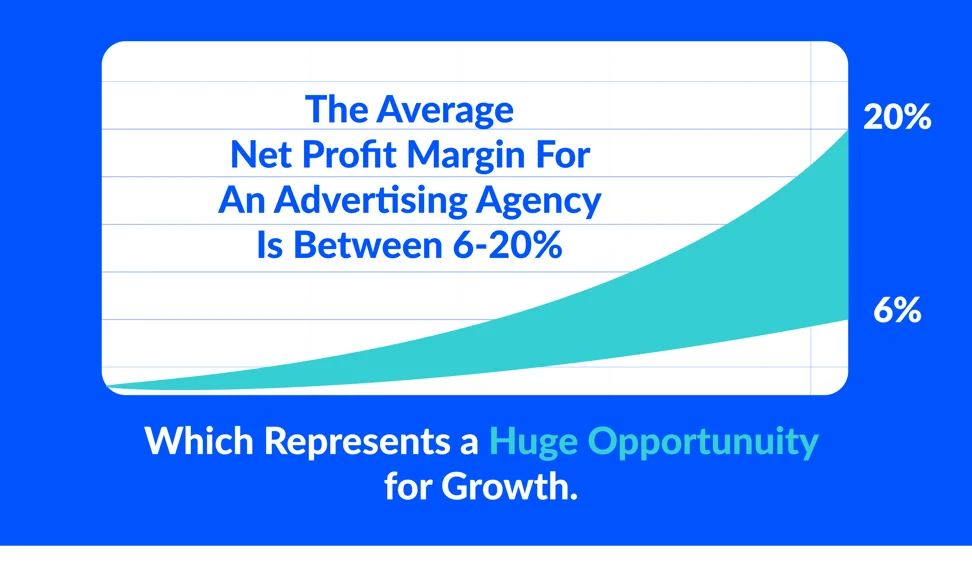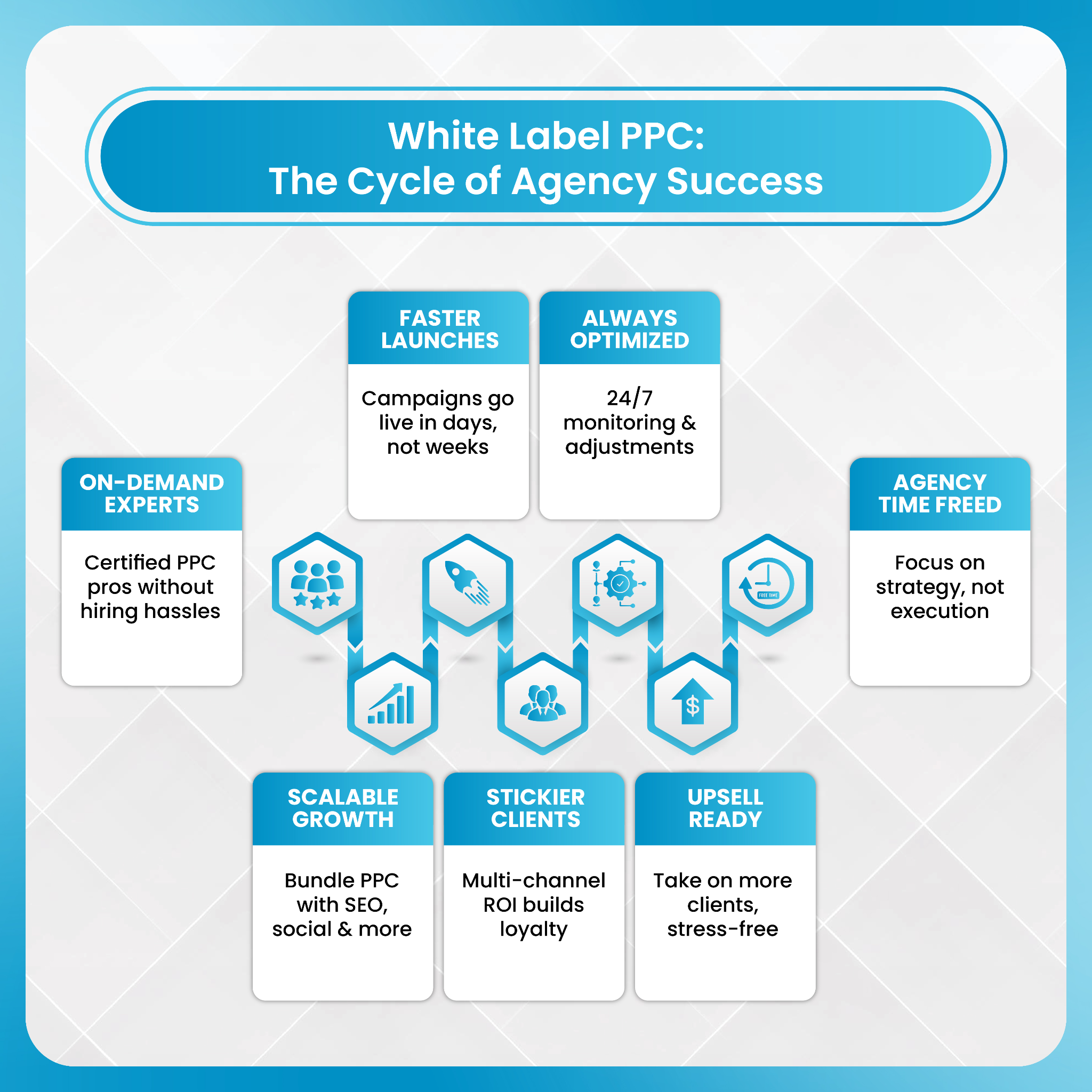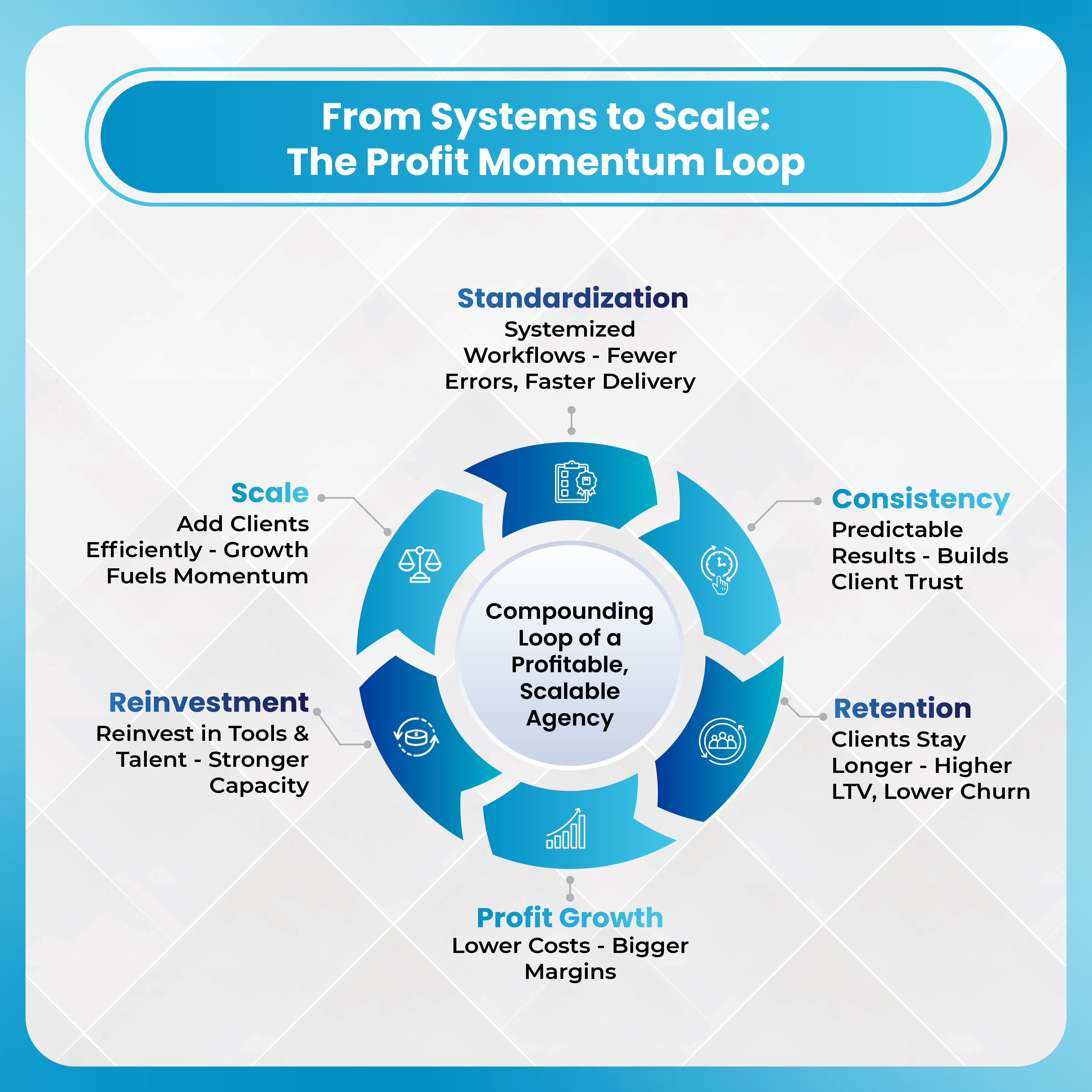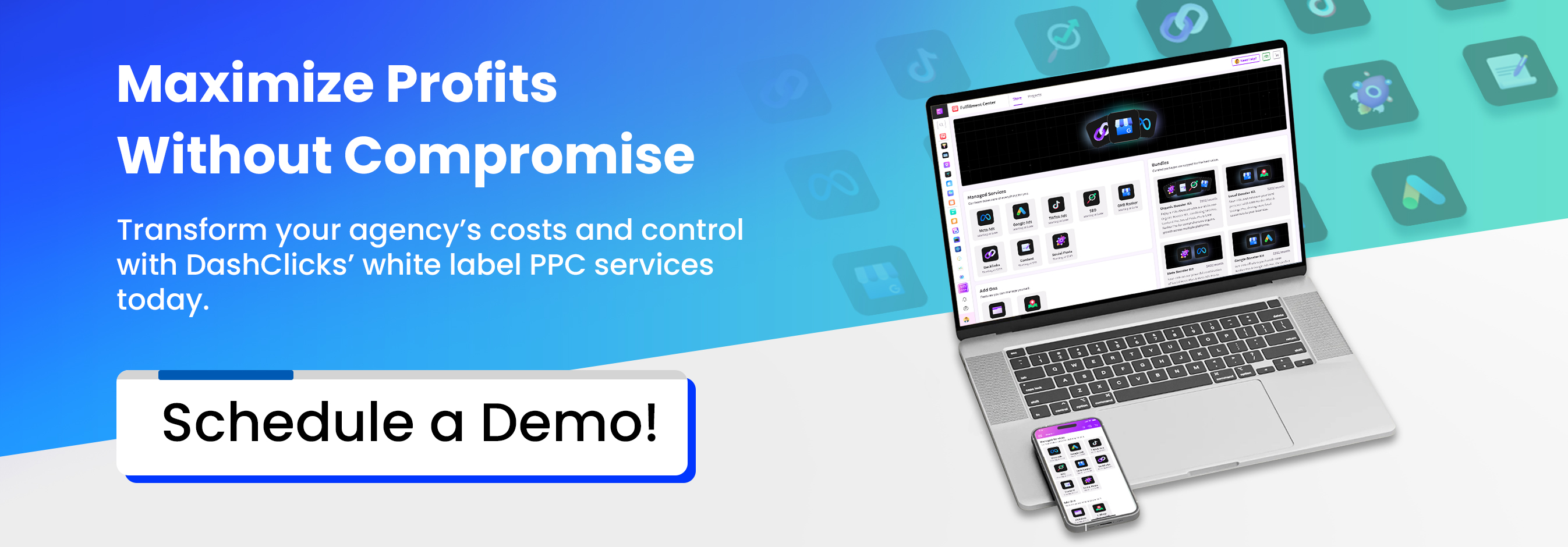Rising advertising costs and tighter client expectations are squeezing agency margins like never before. Google Ads CPCs jumped 15-20% year-over-year across industries in 2024, while client budgets remained flat. For many agencies, this creates a challenging equation: how do you scale profitably when fulfillment costs grow faster than revenue?
The answer lies in finding the perfect balance between cost efficiency and strategic control. While many agencies struggle with either expensive in-house teams or risky full outsourcing, smart agencies are discovering a third path. White label PPC services offer a way to maintain client relationships and strategic oversight while dramatically improving profit margins.
This isn't about giving up control of your campaigns. It's about leveraging specialized expertise and proven systems to transform your cost structure while keeping what matters most under your direct management.
Understanding the Profit Equation in PPC Agencies
Agency profitability comes down to a simple formula: Revenue per client minus all fulfillment costs. But what's changed dramatically is how expensive those fulfillment costs have become.
Labor costs are skyrocketing. PPC talent shortages have driven average salaries up 12-15% year-over-year. A skilled Google Ads specialist now costs $60,000-$80,000 annually, plus benefits and overhead.
Technology expenses keep multiplying. Between bid management tools, analytics platforms, reporting software, and conversion tracking systems, agencies often spend $500-$1,500 per month on tech stacks per campaign manager.
Client churn from inconsistent performance adds hidden costs. Industry data shows that replacing a lost client costs 2-3x more than retaining them, making performance consistency crucial for long-term profitability.
Average marketing agency earns a net profit margin between 6 and 10 percent, with digital agencies reporting even higher margins of around 20 percent. Corporate advertising agencies, in some cases, report margins as high as 40 percent.

Image Source: AskCody
However, Promethean Research's 2024 study found that many agencies fall short of these benchmarks due to fulfillment inefficiencies and rising operational costs.
The key insight? Most agencies don't need more clients – they need better cost-to-control leverage across their PPC operations.
Where Margin Leaks Happen (and Why Most Agencies Miss Them)?
Smart agency owners know that profit leaks often hide in plain sight. Here are the five most common places where margins disappear:
- Leak #1: Overstaffing for Surge Cycles creates expensive downtime. Hiring full-time staff for peak workload means paying for unused capacity during slower periods. An agency paying a PPC manager $6,000 monthly only sees productive work 60-70% of the time on average.
- Leak #2: Time Drain from Repetitive Optimizations kills profitability. Bid adjustments, budget pacing, keyword research, and A/B testing consume hours that don't directly add strategic value. Yet these tasks are essential for campaign performance.
- Leak #3: Rework costs from inconsistent quality compound quickly. Without standardized processes, campaign structures vary by team member, leading to confusion, errors, and time-consuming corrections.
- Leak #4: Technology fragmentation multiplies expenses. Many agencies pay for overlapping tools – separate platforms for reporting, bid management, conversion tracking, and client dashboards – without realizing the total monthly cost.
- Leak #5: Client churn replacement costs devastate margins. HubSpot's 2024 Agency Growth Report confirms that each lost client costs 2-3x more to replace than to retain, making consistent campaign performance essential for long-term profitability.
Consider this example: An agency spending $10,000 monthly on in-house PPC labor typically sees only 35% of those hours spent on true optimization. The rest goes to reporting, administrative tasks, and routine maintenance – activities that don't differentiate the agency or add strategic value.
The Sweet Spot Between Cost and Control
Most agencies fall into one of two traps that hurt profitability:
- Over-Control Approach: Managing everything in-house provides great visibility but poor scalability and low profit margins. You're paying premium salaries for routine tasks while limiting growth potential.
- Over-Outsourcing Approach: Handing off everything to external providers boosts margins but creates client experience risks and dangerous dependency on partners you can't directly manage.
The sweet spot lies between these extremes. Successful agencies retain strategic control over budgeting, account architecture, client communication, and reporting while outsourcing repetitive execution and specialized technical work.
This approach follows a simple framework: "Control where it matters, outsource where it compounds."
Agencies using hybrid outsourcing models report improvement in gross margins without compromising service quality. They maintain direct relationships with clients while benefiting from specialized expertise and economies of scale.
How White Label PPC Services Unlock Margin Growth?
White label PPC services directly address each profit lever in your agency's equation. Here's how they transform your economics:
1. Fixed-Cost to Variable-Cost Transformation
Traditional hiring creates fixed monthly expenses regardless of workload. White label services convert payroll into flexible fulfillment costs that scale with your revenue.
Instead of paying a Google Ads strategist $6,000 monthly (plus benefits and overhead), you pay per-account costs that average 40-50% less. During slow periods, your costs decrease proportionally. During growth phases, you avoid the lag time and risk of hiring new team members.
2. Efficiency Through Specialization
White label providers manage thousands of campaigns across multiple industries. This volume creates pattern recognition and benchmark data that individual agencies can't match internally.
Testing cycles accelerate because providers have seen similar challenges across many accounts. Campaign structures are pre-optimized based on proven frameworks. This "speed-to-optimization" improvement reduces the crucial first 30-60 days when client churn risk is highest.
3. Technology Leverage Without Additional Licensing
Most white label partners include advanced tools within their service pricing. Agencies gain access to enterprise-level bid management platforms, conversion tracking systems, and automated reporting tools without separate licensing fees.
For example, services often include smart dashboards, multi-channel analytics, and client-ready performance reports – eliminating $500-$1,500 in monthly tool costs per campaign manager.
4. Cross-Platform Expertise
Managing Google Ads, Meta, LinkedIn, and Bing simultaneously becomes cost-prohibitive with individual specialists. A White label PPC agency provides pre-built cross-channel frameworks and optimization strategies.
This capability increases average client value by 25-40% as agencies can offer comprehensive paid media strategies rather than single-platform campaigns.
5. Standardization Equals Scale
Productized processes reduce error variance and create predictable delivery timelines. Consistent performance leads to happier clients, longer contracts, and higher lifetime values.
Meanwhile, your internal team can focus on strategy, agency-client relationship management, and business development – activities that generate the highest margins and differentiate your agency.

Calculating the Hidden ROI: A Real Margin Model
Consider this comparison between traditional in-house operations and a hybrid white label PPC approach:
Traditional In-House Model (per client):
- Average monthly retainer: $2,500
- Labor cost per account: $1,200
- Technology and tools: $200
- Management overhead: $400
- Gross margin: 28%
Hybrid White Label Model (per client):
- Average monthly retainer: $2,500
- White label fulfillment: $700
- Technology (included): $0
- Management oversight: $150
- Gross margin: 58%
This represents a 30-percentage-point margin improvement. For an agency managing $600,000 in annual retainer revenue, this translates to an additional $180,000 in gross profit.

Agencies using standardized white label processes achieve higher client retention rates due to consistent performance delivery.
Managing the Control Side: Retaining Strategic Ownership
The key to successful white label PPC partnerships is maintaining control over client-facing activities and strategic decisions. Here's how smart agencies structure these relationships:
- Client communication stays in-house. All client touchpoints, strategy presentations, and performance reviews remain under direct agency control.
- Clear escalation protocols define when external teams consult internal strategists for major decisions or campaign pivots.
- Shared dashboards and transparent reporting eliminate "black box" concerns. Agencies maintain full visibility into campaign performance, optimization activities, and budget allocation.
- Weekly strategy reviews ensure external execution aligns with client goals and agency standards.
Agencies using white label services with defined escalation protocols experience fewer client escalations compared to those with unclear boundaries.
The Cultural ROI: Happier Teams and Clients
Beyond financial benefits, hybrid models create positive cultural changes. Internal teams avoid burnout from repetitive optimization tasks and can focus on strategic work that showcases their expertise.
Client satisfaction improves when campaigns receive consistent, specialized attention. Performance becomes more predictable, and agencies can confidently offer service level commitments.
This virtuous cycle creates internal bandwidth for new business development, leading to higher client lifetime values and sustainable growth.
According to the Digital Agency Network, agencies with specialized outsourcing partners report 20% higher employee retention rates compared to those handling all fulfillment internally.
How DashClicks Helps Agencies Master the Cost-Control Balance?
DashClicks specifically addresses the challenge of maintaining profit margins while scaling PPC operations. Their white label PPC services provide the transparency and control agencies need while delivering the cost efficiency that drives sustainable growth.
The system includes unified dashboards that give agencies real-time visibility into campaign performance across Google Ads, Meta, Bing, and other channels. This eliminates the "black box" concern that often prevents agencies from leveraging external expertise.
Their fulfillment model scales predictably with agency growth. Instead of hiring full-time specialists at $60,000+ annually, agencies pay flexible per-account costs that average 40-50% less than internal alternatives. During peak periods, capacity automatically scales up. During slower months, costs adjust proportionally.
The platform includes all necessary technology – bid management tools, conversion tracking, automated reporting, and client dashboards – within the service cost. This eliminates the technology fragmentation that often adds $500-$1,500 monthly per campaign manager in separate tool licensing.
Most importantly, DashClicks maintains the agency-client relationship. All communication, strategy development, and client presentations remain under direct agency control. The partnership handles execution and optimization while agencies retain strategic ownership and client relationships.
Actionable Framework: 7 Steps to Rebalance Cost and Control
Ready to optimize your agency's profit margins? Follow this systematic approach:
Step 1: Audit Current Cost Structure: Separate strategic activities from execution tasks. Calculate the true cost per hour for each team member, including salary, benefits, and overhead.
Step 2: Identify Underutilized Capacity: Track how much time goes to routine optimizations, reporting, and administrative tasks versus strategic work that differentiates your agency.
Step 3: Select a Partner with Integrated Technology and Fulfillment: Look for providers that include necessary tools within service pricing rather than adding separate software costs.
Step 4: Pilot with 2-3 Existing Accounts: Compare performance metrics and profit margins between traditional and hybrid approaches over 60-90 days.
Step 5: Create Standardized Workflows: Develop clear processes for client communication, strategy approval, and performance review to maintain control while leveraging external expertise.
Step 6: Implement Shared Dashboards: Ensure full visibility into campaign performance and optimization activities to eliminate concerns about outsourcing quality.
Step 7: Scale Systematically: Gradually transition additional accounts while monitoring client satisfaction and internal team satisfaction.
Agencies following this framework typically see 20-30% improvement in net profit per client within 90 days, according to aggregated industry surveys from 2024.
Profitable Growth Through Strategic Partnership
The future of agency profitability isn't about choosing between cost efficiency and strategic control. It's about finding partners that enable both simultaneously.
White label PPC services represent this evolution. The right partnership transforms variable costs into predictable margins while maintaining the client relationships and strategic oversight that differentiate successful agencies.
Smart agencies recognize that sustainable growth requires leverage – the ability to serve more clients profitably without proportional increases in internal resources. This isn't about reducing quality or losing control. It's about focusing internal expertise on activities that create the most value while leveraging external specialists for execution excellence.
The agencies thriving in 2024's challenging economic environment have learned to optimize their profit equation. They control where it matters most and outsource where it compounds their capabilities.



.svg)

.svg)
.svg)
.svg)
.svg)
.svg)

.svg)




.svg)
.svg)
.svg)
.svg)
.svg)